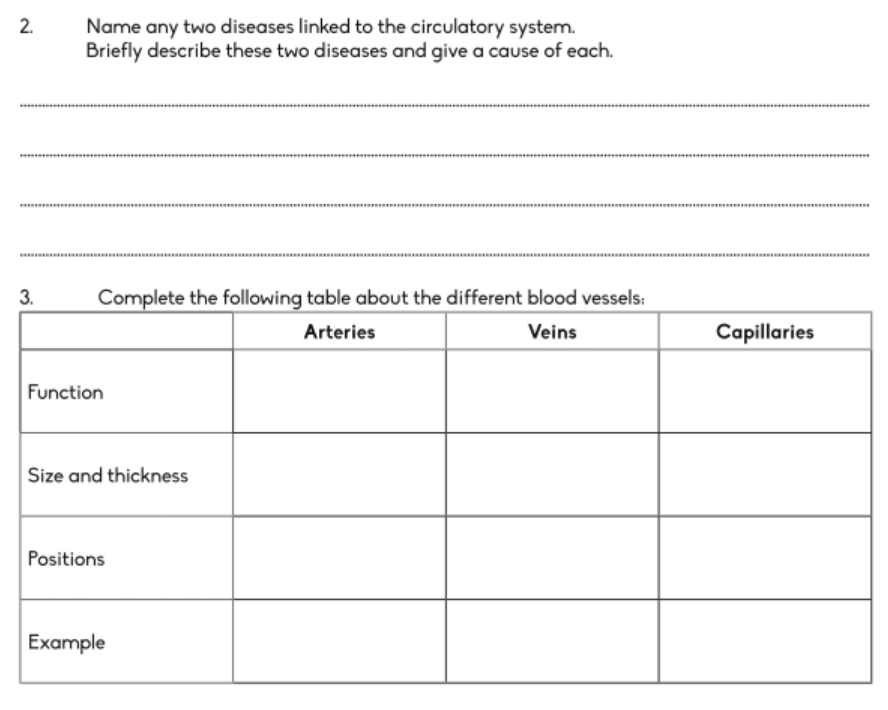1. Name any two diseases linked to the circulatory system. Briefly describe these two diseases and give a cause of each. 2. Complete the following table about the different blood v... 1. Name any two diseases linked to the circulatory system. Briefly describe these two diseases and give a cause of each. 2. Complete the following table about the different blood vessels: Function, Size and thickness, Positions, Example, Arteries, Veins, Capillaries.

Understand the Problem
The image presents two biology questions. The first asks for two diseases linked to the circulatory system, along with a brief description and cause for each. The second asks to complete a table describing the function, size/thickness, positions, and examples of arteries, veins, and capillaries.
Answer
Two circulatory system diseases are: Atherosclerosis, caused by plaque buildup and Heart Attack, caused by a blood flow blockage. The table describes the function, size, position, and examples of arteries, veins, and capillaries.
Two diseases linked to the circulatory system are:
- Atherosclerosis: This is the hardening of the arteries due to a buildup of plaque. A cause is high cholesterol.
- Heart Attack: This occurs when blood flow to the heart is blocked. A cause is a blood clot.
Here is the completed table about blood vessels:
| Arteries | Veins | Capillaries | |
|---|---|---|---|
| Function | Carry oxygenated blood away from the heart. | Carry deoxygenated blood back to the heart. | Allow exchange of oxygen, carbon dioxide, and nutrients between blood and surrounding tissues. |
| Size | Large, thick walls to withstand high pressure. | Medium size, thinner walls compared to arteries. | Very small, one cell thick. |
| Positions | Deep within the body, away from the surface. | Closer to the surface of the body. | Found throughout the body, connecting arteries and veins. |
| Example | Aorta, pulmonary artery, carotid artery. | Vena cava, pulmonary vein, jugular vein. | Found in all tissues. |
Answer for screen readers
Two diseases linked to the circulatory system are:
- Atherosclerosis: This is the hardening of the arteries due to a buildup of plaque. A cause is high cholesterol.
- Heart Attack: This occurs when blood flow to the heart is blocked. A cause is a blood clot.
Here is the completed table about blood vessels:
| Arteries | Veins | Capillaries | |
|---|---|---|---|
| Function | Carry oxygenated blood away from the heart. | Carry deoxygenated blood back to the heart. | Allow exchange of oxygen, carbon dioxide, and nutrients between blood and surrounding tissues. |
| Size | Large, thick walls to withstand high pressure. | Medium size, thinner walls compared to arteries. | Very small, one cell thick. |
| Positions | Deep within the body, away from the surface. | Closer to the surface of the body. | Found throughout the body, connecting arteries and veins. |
| Example | Aorta, pulmonary artery, carotid artery. | Vena cava, pulmonary vein, jugular vein. | Found in all tissues. |
More Information
The circulatory system is responsible for transporting oxygen, nutrients, hormones, and cellular waste throughout the body. Arteries, veins, and capillaries play critical and distinct roles in this process.
Tips
A common mistake is confusing the roles of arteries and veins. Remember that arteries generally carry blood away from the heart while veins carry blood back to the heart. Pulmonary arteries and veins are exceptions to this rule.
Sources
- Circulatory System Diseases: Risk Factors & Symptoms - my.clevelandclinic.org
- Blood Vessels: Types, Anatomy, Function & Conditions - my.clevelandclinic.org
- Cardiovascular System – Blood Vessels and Blood - ecampusontario.pressbooks.pub
AI-generated content may contain errors. Please verify critical information